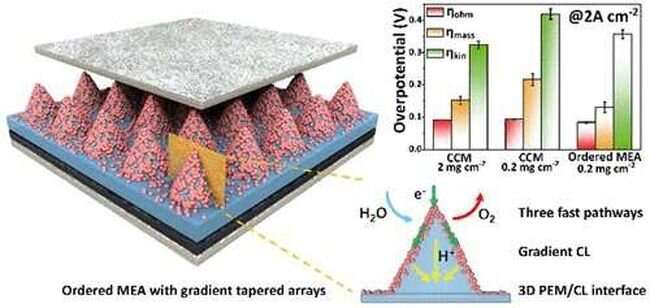Graphical abstract. Credit: Nano Letters (2022). DOI: 10.1021/acs.nanolett.2c03461
Proton exchange membrane water electrolysis (PEMWE) is promising due to its high energy efficiency and hydrogen purity. However, as the practical application of the PEMWEs usually runs at high current densities (≥1–2 A m-2), insufficient catalyst utilization, limited mass transport and high ohmic resistance of the conventional membrane electrode assembly (MEA) restrict the performance of PEMWE.
Recently, a research team led by Prof. Yang Hui from the Shanghai Advanced Research Institute (SARI) of the Chinese Academy of Sciences proposed a novel ordered MEA based on an anode with a 3D membrane/catalytic layer (CL) interface and gradient tapered arrays for high-performance PEMWE.
The study was published in Nano Letters on Dec. 5.
"Benefiting from the maximized triple-phase interface, rapid mass transport and gradient CL, such an ordered structure not only increases the electrochemical active area by 4.2 times but also decreases the overpotentials of both mass transport and ohmic polarization by 13.9% and 8.7%, respectively," said Prof. Yang.
This ordered MEA ensures a performance of 1.801 V @ 2 A cm-2 even with Ir loading as low as 0.2 mg cm-2, which is comparable with conventional MEA with Ir loading of 2 mg cm-2. Further, it can operate stably over 300 h under 1 A cm-2.
The study provides a simple but effective strategy for the overall design of nanostructured MEA for high-performance and stable PEMWE with low Ir loading.
More information: Shu Dong et al, Overall Design of Anode with Gradient Ordered Structure with Low Iridium Loading for Proton Exchange Membrane Water Electrolysis, Nano Letters (2022). DOI: 10.1021/acs.nanolett.2c03461
Journal information: Nano Letters
Provided by Chinese Academy of Sciences
























